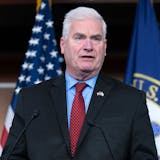Hennepin County needs to dramatically change how it deals with solid waste if leaders are going to close a controversial trash incinerator and not send more garbage to landfills.
That was the takeaway from a 39-page briefing on “reinventing the county’s solid waste system” presented Thursday in response to a unanimous resolution from the County Board in October asking what it would take to close the Hennepin Energy Recovery Center (HERC). The incinerator on the edge of downtown Minneapolis burns about half of residents’ trash and commissioners want to close it before 2040.
“What I’m hearing today is that 2028 to 2040 is not realistic. Let’s make it realistic,” said Commissioner Angela Conley, one of several board members who pushed to close the HERC. “We have to take bold action.”
Conley and other commissioners noted the detailed strategy outlined by staff. It laid out hundreds of millions of dollars in new spending and ambitious state and local policy changes needed to meet the county’s goal of a zero-waste future.
An even more detailed report is expected to be sent to commissioners in early February. What county officials haven’t done is set a specific timeline for shutting down the incinerator.
The lack of a date to stop burning trash is frustrating for activists from groups like the Zero Burn Coalition and Minnesota Environmental Justice Table, who have pushed for years to close the HERC. They say emission from the incinerator contributes to adverse health outcomes in surrounding communities, including higher rates of asthma.
County staff and HERC workers dispute these claims, saying the facility’s emissions are well controlled and are less of a risk to residents’ health and the environment than trucking waste to landfills. State data shows the facility’s emissions are under permitted levels.
Nazir Khan, of the Environmental Justice Table, said the level of detail in the county’s presentation made it clear officials were serious about closing the incinerator. But much more needs to be done to engage with residents and help them understand the impacts of the incinerator and its eventual closure.



